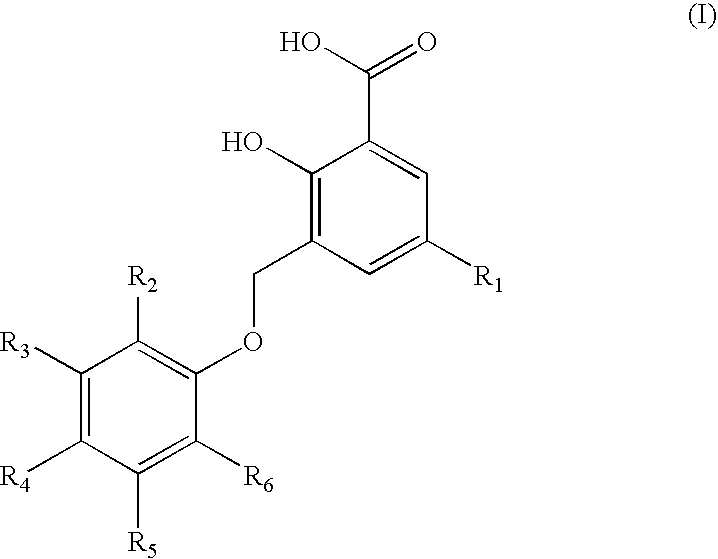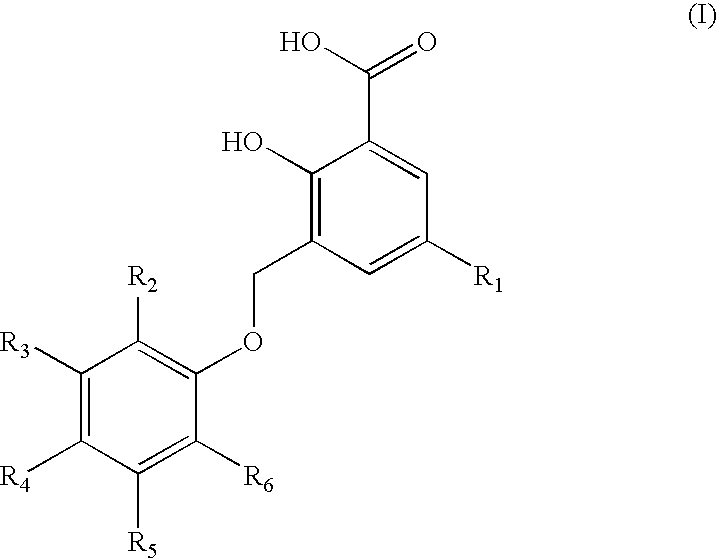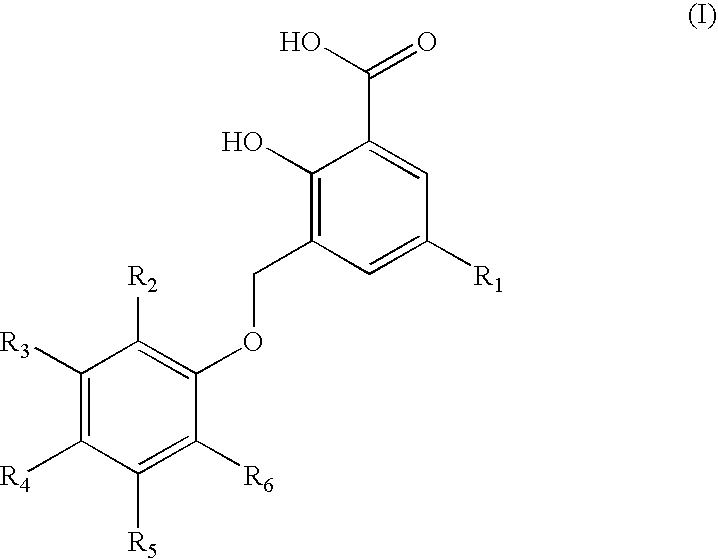Ligands of adenine nucleotide translocase (ANT) and compositions and methods related thereto
a technology which is applied in the field of ligands of adenine nucleotide translocase and compositions and methods related thereto, can solve the problems of affecting the mitochondria themselves, generating highly reactive free radicals that have the potential of damaging cells and tissues, and affecting the ability of free radical mediated damage to inactivate one or more, so as to achieve the effect of facilitating or affecting treatment or preventing
- Summary
- Abstract
- Description
- Claims
- Application Information
AI Technical Summary
Benefits of technology
Problems solved by technology
Method used
Image
Examples
example 1
Synthesis of Representative Compounds
[0069]These examples illustrate the preparation of certain representative compounds.
A. General Synthesis of 3-Aryloxymethyl Analogs of Salicylic Acid
Synthesis of 3-methylsalicyclic acid methyl ester, structure 2:
[0070]A mixture of 3-methylsalicyclic acid 1 (15.2 g, 100 mmol), MeOH (300 mL), and concentrated H2SO4 (40 mL) was refluxed overnight. The excess amount of MeOH was evaporated under reduced pressure, and then the residue was diluted carefully with H2O and extracted with EtOAc twice. The combined organic layer was washed with saturated NaHCO3, brine, and dried over Na2SO4, filtered, concentrated, and the residue was purified by column chromatography on silica gel (EtOAc / hexane: 5 / 95) to give structure 2 (13.8 g, 83%) as a colorless oil.
Synthesis of Structure 3:
[0071]To a solution of DMAP (561 mg, 4.59 mmol), Et3N (12.8 mL, 91.8 mmol) and AcCl (5.41 g, 68.9 mmol) in CH2Cl2 (150 mL) was added structure 2 (7.62 g, 45.9 mmol) in CH2Cl2 at 0° ...
example 2
Representative Compounds of Structure (I)
[0089]
TABLE 2(I)Cpd.R1R2R3R4R5R61—CH3—C(CH3)3—H—H—H—C(CH3)32—CH3—H—H—H—H3—CH3—H—H—C(CH3)3—H—H4—CH3—H—H—Cl—H—H5—CH3—H—H—H—Cl—Cl6—CH3—H—H—H—H7—CH3—H—H—C(CH3)2CH2CH3—H—H8—CH3—H—H—C6H5—H—H9—CH3—H—H—H—Cl—H10—CH3—H—H—H—H11—CH3—H—H—H—C(CH3)3—H12—CH3—H—H—H—H—C6H513—CH3—H—H—H—H14—H—H—H—H—H15—H—H—Br—H—H16—H—H—H—H—OCH2CH317—CH3—H—H—H18—CH3—H—H19—CH3—C(CH3)3—H—CH3—H—C(CH3)320—CH3—H—H—CH3—H—H21—H—H—H—H22—H—H—OCH323—H—H—H—H—CH2OH24—H—H—H—H25—CH3—H—C(CH3)3—H—C(CH3)326—CH3—H—H—H—H—C(CH3)327—H—H—H—H—H28—H—H—H—C(CH3)2CH2CH3—H—H29—H—H—H—H—H30—CH3—H—H—Br—H—H31—CH3—H—H—Cl—H—CH332—CH3—H—H—H—H33—CH3—H—H—H—H34—CH3—H—H—H—H35—CH3—H—H—I—H—H36—CH3—H—H—H—I—H37—CH3—H—H—CH2CH3—H—H38—CH3—H—CH3—H—CH3—CH339—CH3—H—H—H40—CH3—H—H—H—H—I41—CH3—H—H—H—Br—H42—CH3—H—CH3—H—H—F43—CH3—H—H—Cl—H—Cl44—H—H—C(CH3)3—H—H45—H—H—C(CH3)3—H—H46—H—H—C(CH3)3—H—H47—H—H—C(CH3)3—H—H48—H—H—C(CH3)3—H—H49—H—H—C(CH3)3—H—H50—H—H—C(CH3)3—H—H51—H—H—C(CH3)3—H—H52—H—H—C(CH3)3—H—H53—H—H—C(CH3)3—H—H54—H—H—C(CH3)3—...
example 3
ANT Ligand Binding Assay of Representative Compounds
[0090]A competitive binding assay measuring the ability of compounds 1-73 to bind to an ANT polypeptide was performed. A modification of the procedures set forth in U.S. Ser. No. 09 / 569,327 entitled “Production of Adenine Nucleotide Translocator (ANT), Novel ANT Ligands and Screening Assays Therefor” (incorporated herein by reference) was utilized. In brief, competitive binding assays were performed using purified mitochondria from mammalian tissue or from T. ni cells infected with a baculovirus expressing ANT protein. The mitochondria were incubated with 0.5 nm of a labeled atractyloside derivative (e.g., 125I-ATR) and 20 μM of the compound to be tested or a control compound. After incubation of the mitochondria preparation with the compound and the labeled ligand, the reaction is applied to filter paper, the filter paper washed to remove non-specific binding, then dried and the bound radioactivity determined via scintillation cou...
PUM
| Property | Measurement | Unit |
|---|---|---|
| diameter | aaaaa | aaaaa |
| molecular weights | aaaaa | aaaaa |
| electrochemical potential | aaaaa | aaaaa |
Abstract
Description
Claims
Application Information
 Login to View More
Login to View More - R&D
- Intellectual Property
- Life Sciences
- Materials
- Tech Scout
- Unparalleled Data Quality
- Higher Quality Content
- 60% Fewer Hallucinations
Browse by: Latest US Patents, China's latest patents, Technical Efficacy Thesaurus, Application Domain, Technology Topic, Popular Technical Reports.
© 2025 PatSnap. All rights reserved.Legal|Privacy policy|Modern Slavery Act Transparency Statement|Sitemap|About US| Contact US: help@patsnap.com



